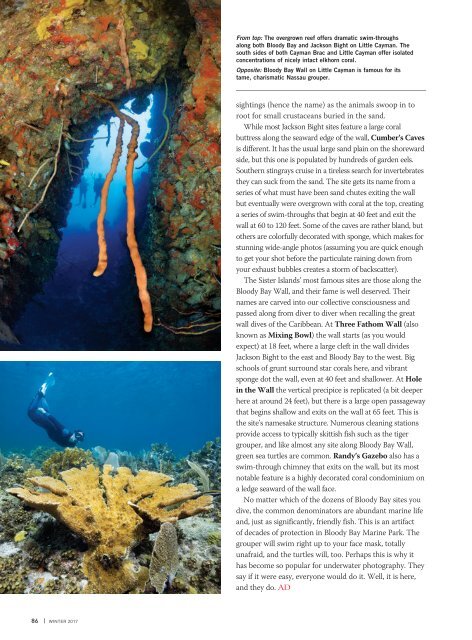AD 2017 Q1
Alert Diver is the dive industry’s leading publication. Featuring DAN’s core content of dive safety, research, education and medical information, each issue is a must-read reference, archived and shared by passionate scuba enthusiasts. In addition, Alert Diver showcases fascinating dive destinations and marine environmental topics through images from the world’s greatest underwater photographers and stories from the most experienced and eloquent dive journalists in the business.
Alert Diver is the dive industry’s leading publication. Featuring DAN’s core content of dive safety, research, education and medical information, each issue is a must-read reference, archived and shared by passionate scuba enthusiasts. In addition, Alert Diver showcases fascinating dive destinations and marine environmental topics through images from the world’s greatest underwater photographers and stories from the most experienced and eloquent dive journalists in the business.
You also want an ePaper? Increase the reach of your titles
YUMPU automatically turns print PDFs into web optimized ePapers that Google loves.
From top: The overgrown reef offers dramatic swim-throughs<br />
along both Bloody Bay and Jackson Bight on Little Cayman. The<br />
south sides of both Cayman Brac and Little Cayman offer isolated<br />
concentrations of nicely intact elkhorn coral.<br />
Opposite: Bloody Bay Wall on Little Cayman is famous for its<br />
tame, charismatic Nassau grouper.<br />
sightings (hence the name) as the animals swoop in to<br />
root for small crustaceans buried in the sand.<br />
While most Jackson Bight sites feature a large coral<br />
buttress along the seaward edge of the wall, Cumber’s Caves<br />
is different. It has the usual large sand plain on the shoreward<br />
side, but this one is populated by hundreds of garden eels.<br />
Southern stingrays cruise in a tireless search for invertebrates<br />
they can suck from the sand. The site gets its name from a<br />
series of what must have been sand chutes exiting the wall<br />
but eventually were overgrown with coral at the top, creating<br />
a series of swim-throughs that begin at 40 feet and exit the<br />
wall at 60 to 120 feet. Some of the caves are rather bland, but<br />
others are colorfully decorated with sponge, which makes for<br />
stunning wide-angle photos (assuming you are quick enough<br />
to get your shot before the particulate raining down from<br />
your exhaust bubbles creates a storm of backscatter).<br />
The Sister Islands’ most famous sites are those along the<br />
Bloody Bay Wall, and their fame is well deserved. Their<br />
names are carved into our collective consciousness and<br />
passed along from diver to diver when recalling the great<br />
wall dives of the Caribbean. At Three Fathom Wall (also<br />
known as Mixing Bowl) the wall starts (as you would<br />
expect) at 18 feet, where a large cleft in the wall divides<br />
Jackson Bight to the east and Bloody Bay to the west. Big<br />
schools of grunt surround star corals here, and vibrant<br />
sponge dot the wall, even at 40 feet and shallower. At Hole<br />
in the Wall the vertical precipice is replicated (a bit deeper<br />
here at around 24 feet), but there is a large open passageway<br />
that begins shallow and exits on the wall at 65 feet. This is<br />
the site’s namesake structure. Numerous cleaning stations<br />
provide access to typically skittish fish such as the tiger<br />
grouper, and like almost any site along Bloody Bay Wall,<br />
green sea turtles are common. Randy’s Gazebo also has a<br />
swim-through chimney that exits on the wall, but its most<br />
notable feature is a highly decorated coral condominium on<br />
a ledge seaward of the wall face.<br />
No matter which of the dozens of Bloody Bay sites you<br />
dive, the common denominators are abundant marine life<br />
and, just as significantly, friendly fish. This is an artifact<br />
of decades of protection in Bloody Bay Marine Park. The<br />
grouper will swim right up to your face mask, totally<br />
unafraid, and the turtles will, too. Perhaps this is why it<br />
has become so popular for underwater photography. They<br />
say if it were easy, everyone would do it. Well, it is here,<br />
and they do. <strong>AD</strong><br />
86 | WINTER <strong>2017</strong>









